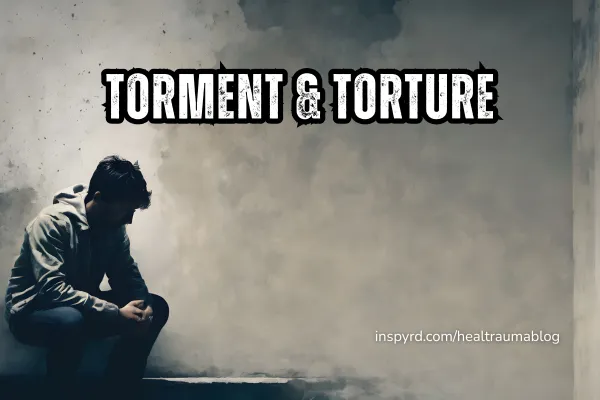
Torment & Torture: The Hidden Costs of Unresolved Trauma
Torment & Torture: The Hidden Costs of Unresolved Trauma
Trauma is not a disorder — it’s an injury that can heal. But before healing begins, we need to name what trauma steals.
Three Paths to Trauma
1. It happens to you — assault, crash, betrayal, or sudden loss.
2. You harm someone else — a medical error, a vehicle accident, or an act of violence that leaves guilt in its wake.
3. You witness harm and can’t intervene — helpless witnessing, especially paired with guilt, is often the most traumatizing experience.
These experiences leave neural imprints that the body and brain will replay until they are safely re-encoded.
The First Theft: Sleep
When the fight–flight–freeze circuitry stays switched on, the brain’s nightly housekeeping shuts down. During normal REM sleep, the hippocampus and amygdala cooperate to strip emotion from memory and file it into long-term storage. Trauma keeps the amygdala screaming 'danger!' long after the threat is gone.
The result? Nightmares, night terrors, and 2–4 abrupt wake-ups per night. No deep sleep means no overnight therapy — the term neuroscientist Matthew Walker uses to describe how REM repairs emotional balance. Without it, the brain can’t separate the feeling of fear from the fact of what happened.
Sleep deprivation compounds trauma. Hormones like cortisol remain elevated, while serotonin and dopamine drop. Over time, the nervous system forgets how to stand down.
If you’re waking every night, you’re not only tired — you’re being robbed of your brain’s built-in healing cycle.
Torment: What the Mind Endures
Torment is the mental echo of unfinished danger. When the brain can’t complete emotional processing, working memory stays jammed — a cluttered desktop of unresolved files. The next morning, you wake up already full. Every request, noise, or demand hits a system with no capacity left.
Clinically, this shows up as:
- Cognitive fog and decision fatigue
- Over-reactivity — a hair-trigger startle or anger response
- Hypervigilance — constant environmental scanning for threat
- Loss of temporal orientation — pulling the negative past into the present and projecting it into the future
Over weeks and months, the brain wires these loops into default pathways. The trauma is no longer an event — it becomes an operating system.
People often say: “I wake up tense. I go to bed tense. Even when nothing’s wrong, my mind keeps searching for what could go wrong.”
That’s mental torment: the body believing it’s still in yesterday’s danger while living in today’s world.
Left untreated, torment can manifest as PTSD, generalized anxiety, panic disorder, or dissociation. The longer it persists, the more neural real estate it occupies, crowding out joy, creativity, and empathy.
But here’s the hope: the same neuroplasticity that built those patterns can unbuild them. With precise interventions that calm the amygdala and reopen working memory capacity, the loop can finally end.
Torture: What the Body Carries
If torment is the mind’s storm, torture is the body’s weather system — the physical aftershock of chronic stress chemistry.
When trauma remains unresolved, the sympathetic nervous system floods the body with adrenaline and cortisol while suppressing immune and digestive function. Over years, this constant activation turns into physical pain syndromes:
- Fibromyalgia — widespread pain without tissue damage
- Chronic fatigue and insomnia
- Irritable Bowel Syndrome (IBS)
- Chronic inflammation, migraines, or autoimmune flares
Bessel van der Kolk calls this 'the body keeping the score.' Gabor Maté goes further: 'The body says no when the mind says yes to unbearable stress.'
Somatic therapies can soothe these patterns by lowering physiological arousal. But lasting freedom often requires resolving the root neural memory network that keeps the stress signal alive.
In my clinical work, I’ve watched this transformation many times:
- Shane, a frontline medic, suffered life-threatening hives for years — his skin erupting every time his nervous system spiked. During trauma-release work, the hives visibly subsided before our eyes. They’ve been 99% gone ever since.
- A 38-year-old client, disabled by fibromyalgia and reliant on a walker, reclaimed full mobility and full-time work after releasing the core traumatic memories from childhood abuse.
These are not miracles — they’re neurobiological reorganizations. When the limbic system updates its threat record, the body stops producing protective pain chemistry.
When the brain updates memory, the body often follows.
Why I Use NLP + Neuroscience
Most therapies manage symptoms; we target causes. By identifying and releasing the first or most significant traumatic imprint, the brain can re-code its entire threat map. The amygdala scans forward and backward in time, normalizing related events. Sleep returns. Calm returns. Choice returns.
You’re not broken. You’re injured — and injuries can heal.